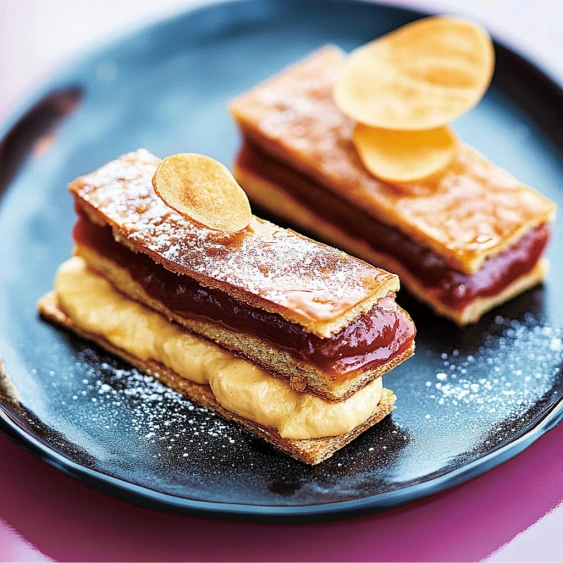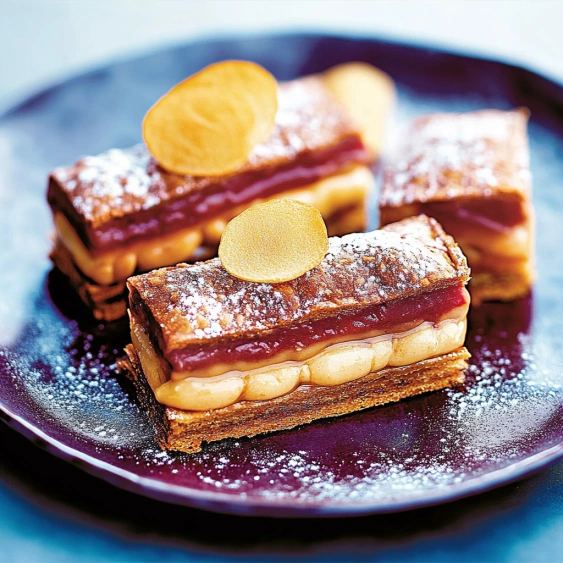 Pin it
Pin it
This elegant rhubarb and custard millefeuilles transforms simple ingredients into a show-stopping French pastry that balances crisp, buttery layers with silky vanilla custard and tart rhubarb compote. The combination of textures and flavors creates a dessert that looks complicated but comes together with surprising ease.
I first made these for a spring dinner party when I needed something elegant but didn't have all day to bake. My guests were convinced I'd purchased them from a patisserie, and they've become my signature dessert for special occasions.
Ingredients
- Puff pastry: one 375g ready rolled sheet that creates the crisp, flaky layers without any fuss
- Egg: for brushing the pastry to achieve that gorgeous golden shine
- Caster sugar: adds sweetness and helps the pastry caramelize beautifully
- Egg yolks: create richness in the custard for a silky smooth texture
- Cornflour: thickens the custard without making it gummy
- Whole milk: provides the perfect fat content for luxurious custard
- Vanilla pod: offers authentic flecks and deep flavor that extract cannot match
- Forced rhubarb: the pink early season variety has a more delicate flavor and vibrant color
- Icing sugar: creates that professional dusted finish that melts on the tongue
Step-by-Step Instructions
- Prepare the custard:
- Whisk egg yolks with sugar until pale and thick before incorporating cornflour. This initial beating creates air that helps the custard remain light despite its richness. The cornflour must be thoroughly mixed in to prevent lumps.
- Infuse the milk:
- Heat milk with real vanilla seeds and pod to extract maximum flavor. This step perfumes the milk with vanilla essence that forms the foundation of your custard.
- Create the custard:
- Slowly pour hot milk into egg mixture while whisking vigorously to prevent scrambling. Return to clean pan and whisk continuously over medium heat until it reaches the perfect consistency. Watch for the first bubble as your signal to remove from heat immediately.
- Cool and prepare the custard:
- Transfer to a wide bowl to speed cooling then chill in a piping bag for easy assembly later. The wide bowl increases surface area allowing faster cooling and preventing a skin from forming.
- Prepare the pastry:
- Cut puff pastry into twelve identical rectangles measuring 4cm x 10cm. Brush with beaten egg and sprinkle with caster sugar which creates a sweet shiny top that caramelizes during baking.
- Bake the pastry:
- Use the double baking tray method to prevent uneven rising ensuring flat uniform layers. This technique keeps the pastry crisp yet prevents it from puffing too much maintaining the classic millefeuille structure.
- Prepare the rhubarb:
- Toss rhubarb pieces in sugar and bake until tender but still holding shape. The sugar not only sweetens but helps draw out moisture while maintaining structural integrity.
- Assemble with precision:
- Begin with custard dollops to anchor the first pastry layer followed by rhubarb and more pastry. Pipe custard in attractive lines between layers creating visual appeal and ensuring every bite contains all elements.
 Pin it
Pin it
Rhubarb holds a special place in my heart as it grew abundantly in my grandmother's garden. She taught me to appreciate its natural tartness and how it transforms when properly sweetened. When I serve these millefeuilles I always think of her showing me how to harvest the pink stalks carefully leaving the poisonous leaves behind.
The Perfect Rhubarb
Forced rhubarb grown in darkened sheds produces the most tender vibrant pink stalks ideal for this recipe. Available from January through March this early season variety requires less sugar and cooks more quickly than its outdoor counterpart. The thinner younger stalks need no peeling and break down beautifully during baking. If using regular garden rhubarb increase the sugar slightly to compensate for its sharper flavor.
 Pin it
Pin it
Make Ahead Options
The custard can be prepared up to two days in advance and kept refrigerated in an airtight container with plastic wrap pressed directly onto the surface to prevent skin formation. The pastry rectangles can be baked the day before and stored in an airtight container at room temperature. Even the rhubarb compote will keep for up to three days refrigerated. Simply bring all components to room temperature before assembly for the best texture and flavor experience.
Troubleshooting Tips
If your custard becomes lumpy pass it through a fine sieve before chilling to restore smoothness. Should your pastry puff unevenly simply trim the tops with a serrated knife after baking. For rhubarb that seems too watery after baking strain off excess liquid and reduce it in a small saucepan until syrupy then pour back over the rhubarb for intensified flavor without sogginess.
Frequently Asked Questions
- → Can I make components of this millefeuilles ahead of time?
Yes! The custard can be made 1-2 days ahead and kept refrigerated in an airtight container. The rhubarb compote can also be prepared a day in advance. The puff pastry rectangles are best baked on the day of serving to maintain crispness, but can be baked a few hours ahead. Assemble just before serving to prevent the pastry from becoming soggy.
- → What can I substitute for forced rhubarb?
Regular field rhubarb works well as a substitute, though it may need slightly longer cooking time and possibly more sugar as it's typically less tender and more tart than forced rhubarb. Alternatively, strawberries, raspberries, or poached pears make excellent substitutions if rhubarb is unavailable.
- → Why does my puff pastry need to be weighted down during baking?
Weighting the puff pastry with a second baking sheet prevents it from rising too much, ensuring flat, even layers that stack beautifully. This technique creates the characteristic millefeuilles texture with crisp, thin layers rather than puffy, uneven ones.
- → Can I use store-bought custard instead of making it from scratch?
While homemade custard provides the best flavor and texture, you can substitute with good-quality store-bought custard. Choose a thick variety and consider enhancing it with additional vanilla extract or bean seeds. Ensure it's well-chilled before piping to maintain structural integrity in your millefeuilles.
- → Why did my millefeuilles collapse when I tried to serve it?
Millefeuilles can collapse if the custard is too soft, the rhubarb too wet, or if assembled too far in advance. Ensure your custard is thoroughly chilled and thick enough to pipe with definition. Pat the rhubarb dry of excess juice before using, and always assemble just before serving for the best structural integrity.
- → What's the best way to cut millefeuilles without crushing the layers?
This recipe cleverly avoids cutting issues by pre-cutting the pastry before baking and then stacking individual portions. If you prefer to make one large millefeuille to cut later, use a very sharp serrated knife with a gentle sawing motion, applying minimal downward pressure to prevent crushing the delicate layers.
